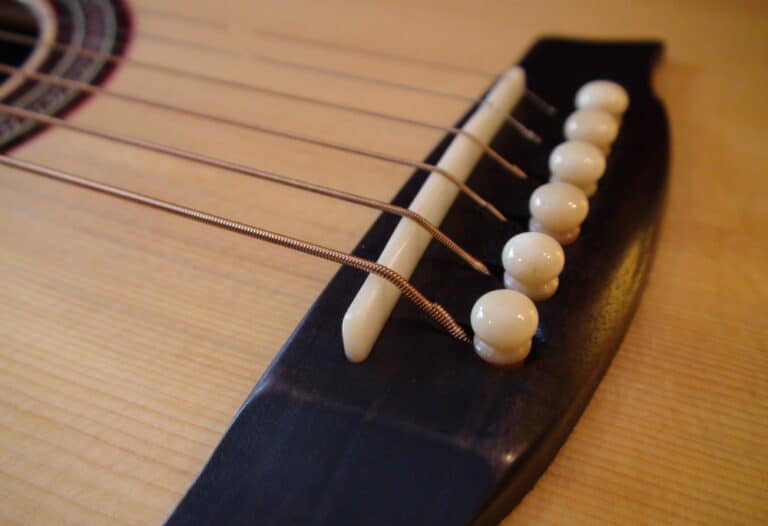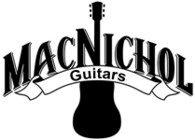How to Find an Acoustic Guitar Saddle Replacement
Guitar saddle replacements come in a variety of materials, compensation patterns, top radii, and sizes. Finding the right replacement saddle for your guitar can prove difficult. In this article, we provide five steps to help you find an acoustic guitar saddle replacement.

Step One: Choose Saddle Material
Factory guitar saddles are often made of plastic, either inexpensive plastic saddles that produce a weak tone, or quality synthetic materials such as Tusq or Micarta. More expensive guitars almost always come with bone saddles leading many to believe that bone necessarily produces a superior tone. However, you may find that you prefer the factory saddle made of synthetic materials to bone. Please visit our article on What is the Best Acoustic Guitar Saddle Material? for more information.Step Two: Determine Saddle Compensation Pattern
Numerous compensation patterns exist, and these are based on factors such as scale length and bridge saddle slot angle. Generally speaking, you should replace your saddle with the same compensation pattern used from the factory. However, you should only try a different compensation pattern if you are having intonation problems, or if you plan to use alternate tunings. For more information, please see our article on Acoustic Guitar Compensation Patterns.
Your bone saddle may be non-compensated, particularly if your guitar was built before the 1990s. Compensation will lengthen or shorten individual strings, but please note that compensation does not necessarily equal improved intonation, and could even make intonation worse. Guitar builders factor in many aspects, such as bridge saddle slot angle, scale length, and string diamater to determine what compensation pattern to use, and so replacing a non-compensated saddle with a compensated saddle might improve some string’s intonation, but make others worse. Also, there are different types of non-compensated saddle. Please see our Guide to Non-Compensated Saddles for more information.
Step Three: Determine Radius
Steel-string acoustic guitar fretboards almost always have a subtle curve to the fretboard for easier playing. Generally speaking, matching your saddle’s top radius to your fretboard radius will produce better playability and reduced buzzing. Please note that guitar manufacturers sometimes use a saddle that has a different radius from that of the fretboard.
The most common fretboard radii for acoustic guitars are 12- and 16- inches, but 14-, 15-, and 20-inch radius fretboards also appear, but you’ll also see fretboard radii listed in mm, such as 300 mm (11.81 inches) or 400 mm (15.75 inches). Manufacturers often use the same radius for all their series, but this is not always the case. For example, Gibson acoustic guitars often have a 12-inch radius fretboard, but some models will have a 16-inch radius. To determine your specific guitar’s fretboard radius, first try contacting the manufacturer with your serial number and ask what the radius is. You can also print radius gauges on cardstock, or purchase machined radius gauges.
Step Four: Measure Length, Height, Thickness, Bass/Treble Edge Height Difference, String Spacing at the Bridge
Guitar saddles come in a variety of lengths, heights, and thicknesses. You can remove your current saddle without completely restringing to measure. A few notes on each of these specs:
Length
Common lengths for steel-string acoustic guitar saddles are 72, 74, or 75 mm, but manufacturers will use other lengths, too. Nylon string guitar saddles are typically 80 mm long.
Thickness
Martin saddles are typically 2.5 mm, or a touch thicker than 3/32 inch. However, a large number of steel string guitar saddles will be around 3.2 mm, or 1/8 inch. Note that many inexpensive aftermarket saddles are made at 3.0 mm thickness. That 0.2 mm might not seem like much but can cause a subtle forward lean in your saddle slot, which in turn can negatively affect intonation and result in poor contact with the bridge.
Height
Saddles will come in a variety of maximum heights, typically anywhere from 8 mm to 13 mm. Measure your current saddle’s height before purchasing a replacement.
Bass/Treble Edge Height Difference
Saddles often come with the bass edge about 1 mm taller than the treble edge. However, your current saddle may have been adjusted on one side more than the other versus the stock saddle. Please see our article on Bass/Treble Edge Height Difference for more information.
String Spacing at the Bridge
Step Five: Where to Find a Saddle Replacement
To find a quality saddle replacement, first try visiting the manufacturer’s websites. However, please note that many manufacturers do not provide purchase links online. Below are links to some common builders, though, where you can purchase direct from the manufacturer.
If you’re unable to purchase direct from the manufacturer, try visiting GraphTech’s acoustic saddle page for Tusq and NuBone saddles. Also check out luthiery supply sites, such as StewMac, which will carry saddles in a variety of materials and sizes.
You can also try Amazon and eBay, however, be aware that you may find some inexpensive bone saddles on these sites. If so, those saddles often contain the incorrect dimensions, such as the wrong top radius for your guitar, or are 3.0 mm thick instead of 3.2 mm. Also, they may use overly porous bone and/or bone processed with harsh chemicals, which might expedite bone processing time, but results in weak bone that produces poor tone. Those inexpensive bone saddles might sound better than the factory plastic saddle does, but they will not compare to the tone produced by a quality bone saddle and are also unlikely to last long.
To find a quality bone saddle, please view our Acoustic Guitar Saddle Size Chart to see whether we have a saddle to fit your guitar model.
